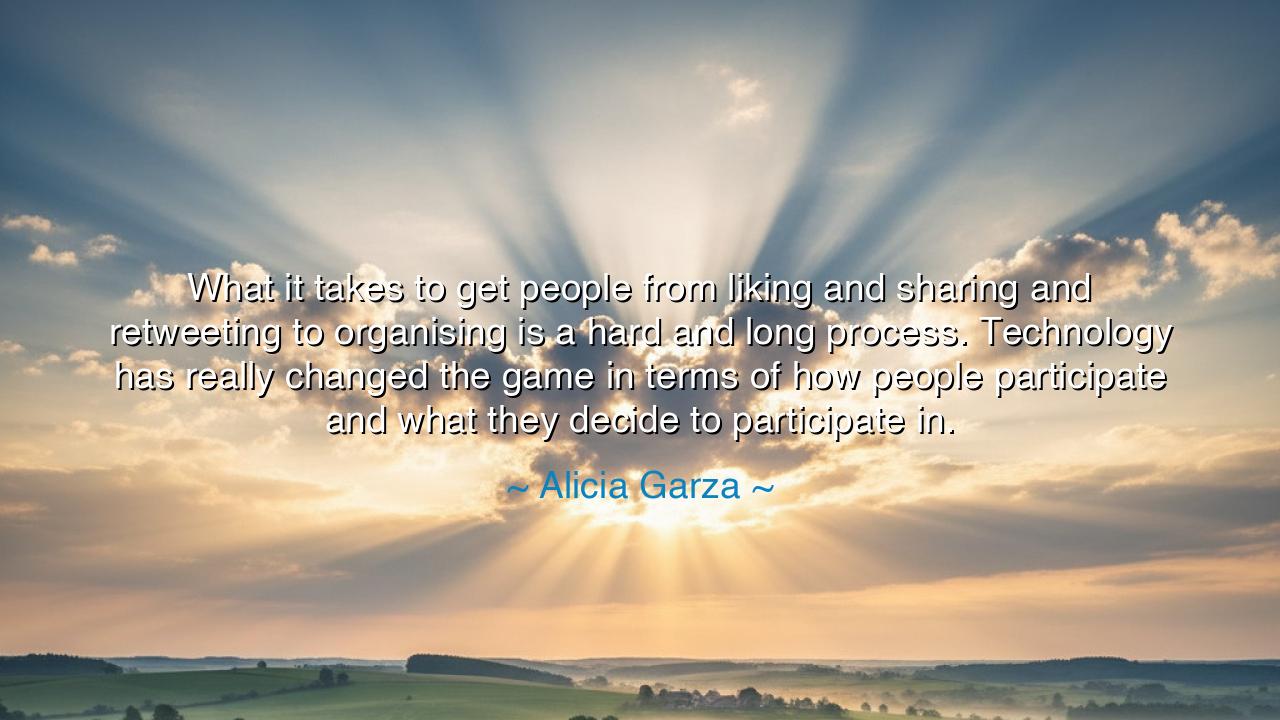
What it takes to get people from liking and sharing and
What it takes to get people from liking and sharing and retweeting to organising is a hard and long process. Technology has really changed the game in terms of how people participate and what they decide to participate in.






Alicia Garza, a voice of courage and justice, speaks with clarity when she declares: “What it takes to get people from liking and sharing and retweeting to organising is a hard and long process. Technology has really changed the game in terms of how people participate and what they decide to participate in.” In these words she unveils a truth of our age: that though technology has given us new powers of connection, the work of true transformation still demands endurance, sacrifice, and the slow labor of building community.
For what is a like, a share, or a retweet, if not the spark of interest? It is the raising of a hand in the vast digital crowd, a signal that says, “I see, I agree, I care.” Yet Garza warns us that sparks alone do not build a fire. A movement cannot live by symbols alone. It must be fed with wood, with fuel, with breath. To move from digital gestures to organising—to gathering in streets, to planning, to acting—is to move from the realm of the easy to the realm of the difficult, from the swift click of a finger to the steady work of commitment.
History bears witness to this truth. Think of the Civil Rights Movement in America. Pamphlets were printed, songs were sung, sermons were spoken—but the true power was not in the messages alone. It was in the marches, the sit-ins, the boycotts, the long nights of strategy in church basements. Words lit the flame, but action carried it forward. In the same way, social media may awaken, but only organising can transform awakening into lasting change.
Yet Garza also acknowledges the power of technology. It has indeed “changed the game.” Where once it took months to spread a message, now it travels the world in seconds. Where once only the powerful could command an audience, now anyone with a phone may speak to millions. Technology has shattered barriers of distance and censorship, giving voice to the voiceless and visibility to the unseen. But with this power comes both temptation and danger: the temptation to confuse digital expression with real action, and the danger that movements may remain forever trapped in the realm of symbols, never crossing into the realm of deeds.
We can look, too, to the Arab Spring as an example. The uprisings began in part because of the spread of messages through social media, a tool that amplified outrage and hope alike. But revolutions did not succeed merely because of tweets or posts—they succeeded, when they did, because bodies filled squares, communities organized, and people bore the risks of change. Technology gave them the voice; organising gave them the power. Without the second, the first fades like wind.
The teaching for us is profound: do not despise the small act of clicking “like,” for it signals awareness and solidarity. But do not stop there. If you would bring true change, you must move beyond the screen into the world. You must stand with others, plan with others, sacrifice with others. True power lies not only in visibility but in unity, in persistence, in the courage to act when action carries cost.
Therefore, O listeners, let Garza’s words guide you: use technology as a tool, not as a substitute. Let it amplify your message, but not replace your movement. Let it awaken hearts, but then join those hearts together in the work of justice, whether in your neighborhood, your city, or your nation. For movements are not built in the silence of clicks, but in the roar of voices joined together, refusing to be ignored.
And so, the lesson is clear: the path from “liking and sharing” to true organising is long and hard, but it is the only path that leads to transformation. Take up that path with courage. Use your tools wisely. And never forget that while technology may light the spark, it is human will, human sacrifice, and human solidarity that turn sparks into fire.






AAdministratorAdministrator
Welcome, honored guests. Please leave a comment, we will respond soon